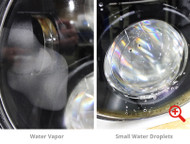Condensation vs Water Leakage On The Inside of Your LED Headlight Lens
Posted by DTA Sales on Oct 29th 2018
Condensation is a naturally occurring condition that can affect any light. It does not suggest a defect in a product, as opposed to what happens when a leak occurs, in which case there is water ingress that could lead to a system failure. The explanation contained herein is intended to help you differentiate between these two conditions so they understand what, if anything, needs to be done.
Condensation is the change of water from a gaseous form (vapor) into liquid water. It appears as small droplets of moisture inside the light. Condensation does not cause a problem with normal operation of the light and is, therefore, NOT considered to be a defect or warrantable condition.
In fact, J.W. Speaker lamps are designed to allow moisture to escape and not re-enter, but it takes time for the moisture to evaporate (the amount of time will depend upon whether or not the light is turned on or not).
Water ingress describes water that leaks into the light, manifesting itself as large droplets and pooling of water that is clearly visible.Sources of water ingress can vary. If a light suffers water ingress as the result of physical abuse and/or misuse, it would not constitute a manufacturing defect.
Otherwise, water ingress caused by a defect in workmanship is a warrantable item. In this event, please contact the dealer who supplied the product to schedule a return.
Virtually all lights are prone to condensate due to the following events:
- Air is trapped inside a lamp when manufactured
- Plastic parts used in lights naturally absorb moisture in the air
- As the light heats up these plastics parts release moisture that mixes with air
- Moisture attaches itself to the coolest part of the lamp, e.g. the lens
- Halogen lamps tend to run hot so the moisture evaporates more quickly
- LED lights produce less heat so moisture takes longer to evaporate, so it can be more noticeable


